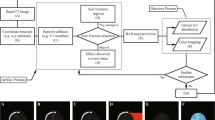Abstract
Objective
At the acute phase of traumatic brain injury (TBI), brain swelling contributes substantially to the development of secondary neurological lesions. Elucidating the pathophysiology of brain swelling is crucial to improve TBI management. In a previous study, specific gravity (SG) of the noncontused hemisphere, as estimated by computed tomography (CT), was higher in patients with high Marshall CT scores and severe brain swelling. The aim of this study was to investigate the relationship between estimated specific gravity (eSG) and clinical variable suggestive of brain swelling.
Design
Retrospective study of data from a prospectively established database.
Setting
Neurology ICU in a teaching hospital in Paris, France.
Participants
We studied 20 patients with severe traumatic brain injury (TBI), 20 patients with high-grade subarachnoid hemorrhage (SAH) presenting similar brain-swelling criteria, 20 patients with low-grade SAH, and 20 healthy controls.
Interventions
None.
Measurements and Results
Estimated brain specific gravity was acquired from CT images obtained at ICU admission. eSG was estimated in the overall intracerebral content and in a region-of-interest composed of white matter and the diencephalon. eSG in the region of interest was significantly higher in the TBI patients than in the high-grade SAH patients (1.0350 ± 0.0041 vs. 1.0310 ± 0.0019 g/ml, P < 0.05). eSG was similar in the high-grade SAH, low-grade SAH, and control groups.
Conclusions
Our findings do not support a causal link between brain swelling and eSG elevation. The eSG increase in severe TBI patients is not due to brain swelling.


Similar content being viewed by others
References
Lescot T, Bonnet MP, Zouaoui A, et al. A quantitative computed tomography assessment of brain weight, volume, and specific gravity in severe head trauma. Intensive Care Med. 2005;31:1042–50. doi:10.1007/s00134-005-2709-y.
Degos V, Lescot T, Zouaoui A, et al. Computed tomography-estimated specific gravity of noncontused brain areas as a marker of severity in human traumatic brain injury. Anesth Analg. 2006;103:1229–36. doi:10.1213/01.ane.0000237401.22688.22.
Weiss N, Sanchez-Pena P, Roche S, et al. Prognosis value of plasma S100B protein levels after subarachnoid aneurysmal hemorrhage. Anesthesiology. 2006;104:658–66. doi:10.1097/00000542-200604000-00008.
Report of World Federation of Neurological Surgeons Committee on a Universal Subarachnoid Hemorrhage Grading Scale. J Neurosurg. 1988;68:985–6.
Fisher CM, Kistler JP, Davis JM. Relation of cerebral vasospasm to subarachnoid hemorrhage visualized by computerized tomographic scanning. Neurosurgery. 1980;6:1–9. doi:10.1097/00006123-198001000-00001.
Korinek AM, Reina M, Boch AL, Rivera AO, De Bels D, Puybasset L. Prevention of external ventricular drain-related ventriculitis. Acta Neurochir (Wien). 2005;147:39–45, discussion 45-6. doi:10.1007/s00701-004-0416-z
Kawamata T, Mori T, Sato S, Katayama Y. Tissue hyperosmolality and brain edema in cerebral contusion. Neurosurg Focus. 2007;22:E5. doi:10.3171/foc.2007.22.5.6.
Habgood MD, Bye N, Dziegielewska KM, et al. Changes in blood–brain barrier permeability to large and small molecules following traumatic brain injury in mice. Eur J NeuroSci. 2007;25:231–8. doi:10.1111/j.1460-9568.2006.05275.x.
Chen Y, Constantini S, Trembovler V, Weinstock M, Shohami E. An experimental model of closed head injury in mice: pathophysiology, histopathology, and cognitive deficits. J Neurotrauma. 1996;13:557–68.
Hicks RR, Baldwin SA, Scheff SW. Serum extravasation and cytoskeletal alterations following traumatic brain injury in rats. Comparison of lateral fluid percussion and cortical impact models. Mol Chem Neuropathol. 1997;32:1–16. doi:10.1007/BF02815164.
Bullock R, Smith R, Favier J, du Trevou M, Blake G. Brain specific gravity and CT scan density measurements after human head injury. J Neurosurg. 1985;63:64–8.
Acknowledgments
This work was supported by two nonprofit organizations, the JEPU and the Fondation des Gueules Cassées. We thank the staff of the neuro-intensive care unit of the Pitié-Salpêtrière Teaching Hospital for their participation in this study and Jorge Gallego for his methodological assistance.
Author information
Authors and Affiliations
Corresponding author
Rights and permissions
About this article
Cite this article
Degos, V., Pereira, AR., Lescot, T. et al. Does Brain Swelling Increase Estimated Specific Gravity?. Neurocrit Care 9, 338–343 (2008). https://doi.org/10.1007/s12028-008-9131-6
Received:
Accepted:
Published:
Issue Date:
DOI: https://doi.org/10.1007/s12028-008-9131-6




